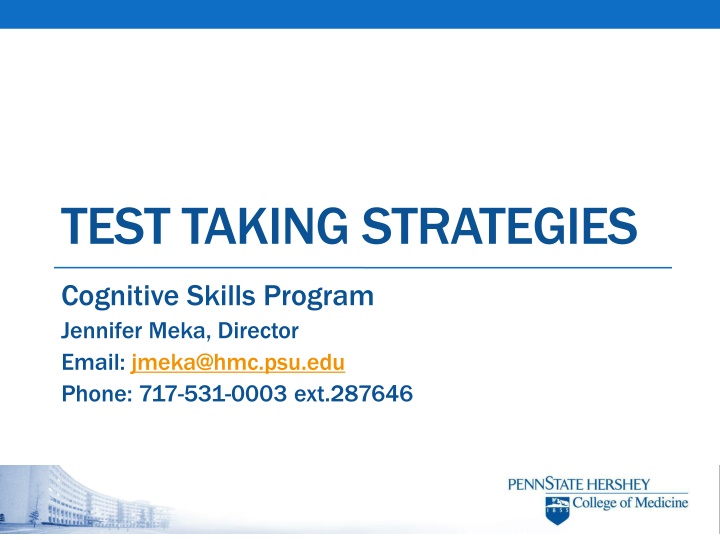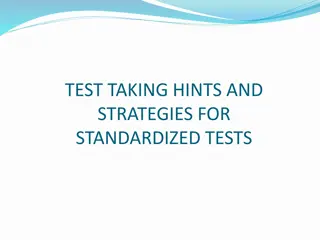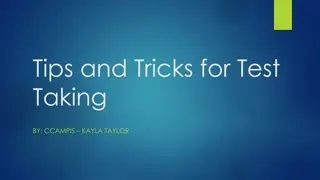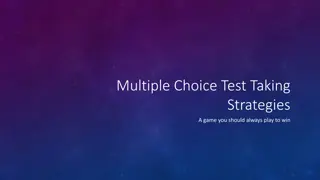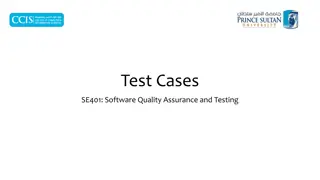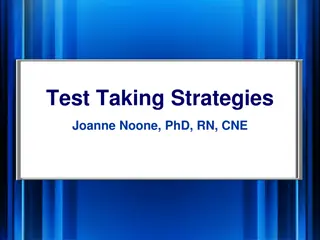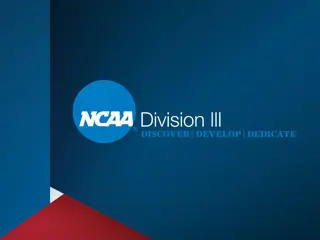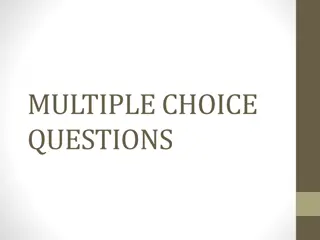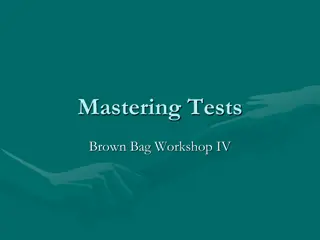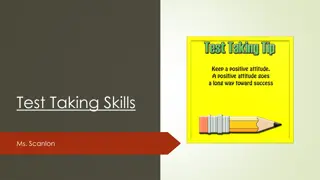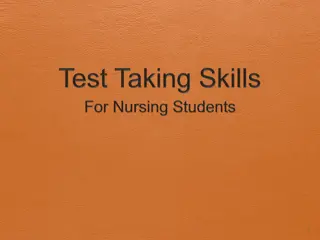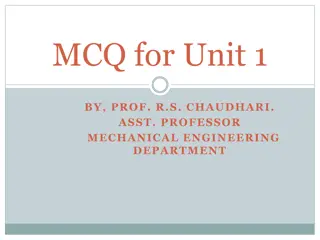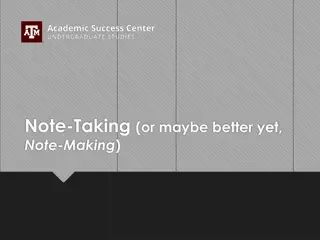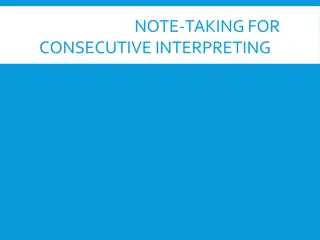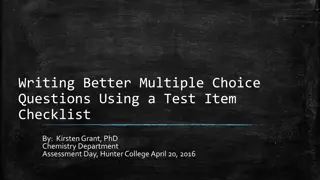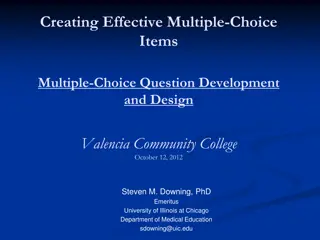Effective Strategies for Mastering Multiple-Choice Questions in Test Taking
General recommendations for approaching multiple-choice questions, common errors to avoid, and step-by-step guidance on how to read, paraphrase, and predict answers in MCQs are covered in this cognitive skills program led by Director Jennifer Meka. The program emphasizes assembling key clues, understanding the question, comparing answer choices, and marking the best response. Practice exercises and examples are provided to enhance test-taking skills and improve performance.
Download Presentation

Please find below an Image/Link to download the presentation.
The content on the website is provided AS IS for your information and personal use only. It may not be sold, licensed, or shared on other websites without obtaining consent from the author.If you encounter any issues during the download, it is possible that the publisher has removed the file from their server.
You are allowed to download the files provided on this website for personal or commercial use, subject to the condition that they are used lawfully. All files are the property of their respective owners.
The content on the website is provided AS IS for your information and personal use only. It may not be sold, licensed, or shared on other websites without obtaining consent from the author.
E N D
Presentation Transcript
TEST TAKING STRATEGIES Cognitive Skills Program Jennifer Meka, Director Email: jmeka@hmc.psu.edu Phone: 717-531-0003 ext.287646
General Recommendations for MC Questions assemble key clues into a mental "snapshot" of the patient understand precisely what is being asked allow a few moments to think, recall, and to anticipate possible answers compare the given choices to your anticipated answer mark choices that match best rule out choices that don't account for all findings mark the best answer
Errors to Avoid Answering a question that is not Focusing on an irrelevant Not identifying important sections of the question Focusing on the answer choices/options not being asked irrelevant fragment of the question
MC Question Approach Steps 1 & 2: Read and Paraphrase 1. 1. Read Read the last sentence the last sentence or two of the question vignette (the actual question) first. you know what to look for in the vignette to answer the question. 2. Read the rest of the question (vignette). Before you look at the answer options, stop to paraphrase paraphrase the case and question. first. This will help
Try it out: Read and Paraphrase A 75-year-old smoker and alcohol abuser is hospitalized for evaluation of a squamous cell carcinoma of the larynx. On his second hospital day, he complains of sweating, tremors, and vague gastrointestinal distress. On physical examination, he is anxious and has a temperature of 101 F, heart rate of 104/min, BP of 150/100 mm Hg, and a respiratory rate of 22 breaths per minute. Later that day, he has three generalized tonic-clonic seizures. Which of the following is the most likely cause of his seizures?
Remember: Read & Paraphrase 1. 1. Read Read the last sentence the last sentence or two of the question vignette (the actual question) first. first. *Share: What do you need to look for? 2 2. Read the rest of the question (vignette). Stop to paraphrase case and question. *Share: What are the key aspects of this case? paraphrase the
MC Question Approach Step 3: Predict 1. Read the last sentence or two of the question vignette (the actual question) first. . This will help you know what to look for in the vignette to answer the question. 2. Read the rest of the question (vignette). Before you look at the answer options, stop to paraphrase the case and question. 3. 3. Predict Predict the answer.
Try it out: Predict A 75-year-old smoker and alcohol abuser is hospitalized for evaluation of a squamous cell carcinoma of the larynx. On his second hospital day, he complains of sweating, tremors, and vague gastrointestinal distress. On physical examination, he is anxious and has a temperature of 101 F, heart rate of 104/min, BP of 150/100 mm Hg, and a respiratory rate of 22 breaths per minute. Later that day, he has three generalized tonic-clonic seizures. Which of the following is the most likely cause of his seizures? Turn to your neighbor and share your prediction. Turn to your neighbor and share your prediction.
MC Question Approach Step 4: Consider Options 1. Read the last sentence or two of the question vignette (the actual question) first. . This will help you know what to look for in the vignette to answer the question. 2. Read the rest of the question (or vignette). Stop to paraphrase the case and question. 3. Predict the answer. 4. 4. Look through the options Look through the options. If you see your answer, pick it.
Try it out: Consider Options A 75-year-old smoker and alcohol abuser is hospitalized for evaluation of a squamous cell carcinoma of the larynx. On his second hospital day, he complains of sweating, tremors, and vague gastrointestinal distress. On physical examination, he is anxious and has a temperature of 101 F, heart rate of 104/min, BP of 150/100 mm Hg, and a respiratory rate of 22 breaths per minute. Later that day, he has three generalized tonic-clonic seizures. Which of the following is the most likely cause of his seizures? A. Brain metastasis B. Febrile seizure C. Hypocalcemia D. Alcohol withdrawal E. Subdural hematoma
MC Question Approach Step 5: Eliminate Incorrect Responses 1. Read the last sentence or two of the question vignette (the actual question) first. This will help you know what to look for in the vignette to answer the question. 2. Read the rest of the question (or vignette). Stop to paraphrase the case and question. 3. Predict the answer. 4. Look through the options. If you see your answer, pick it. 5. 5. If you don t see your answer, begin If you don t see your answer, begin eliminating those you know are incorrect. eliminating those you know are incorrect.
When eliminating responses: Think about the data presented in the question. Use the evidence to make your selection. Avoid adding assumptions or reading more into the question/case than what is presented.
Try it out: Eliminate Incorrect Responses A 75-year-old smoker and alcohol abuser is hospitalized for evaluation of a squamous cell carcinoma of the larynx. On his second hospital day, he complains of sweating, tremors, and vague gastrointestinal distress. On physical examination, he is anxious and has a temperature of 101 F, heart rate of 104/min, BP of 150/100 mm Hg, and a respiratory rate of 22 breaths per minute. Later that day, he has three generalized tonic-clonic seizures. Which of the following is the most likely cause of his seizures? A. Brain metastasis B. Febrile seizure C. Hypocalcemia D. Alcohol withdrawal E. Subdural hematoma
MC Question Approach Step 6: Choose your answer A. Brain metastasis B. Febrile seizure C. Hypocalcemia D. Alcohol withdrawal E. Subdural hematoma
A 4-year-old boy is brought to the local emergency department by his mother because he is not acting right. His mother reports that he seemed well last night, but this morning he was uncharacteristically groggy and appeared flushed. He fell over twice while walking around the house and passed out for 20 seconds while eating breakfast. Although he did not hit his head, he did complain of a headache. On the way to the hospital he vomited once; it was nonbloody and nonbillious. There are no sick contacts in the household, but his father awoke with a severe headache this morning. The family is vacationing at a nearby mountain resort noted for its rustic log cabins with wood-burning fireplaces. The boy s temperature is 37 C (98.6 F), blood pressure is 90/50 mm Hg, pulse is 130/min, and respiratory rate is 26/min. The patient is minimally cooperative; he refuses to walk, preferring to nap in his mother s arms. There is no evidence of head trauma and his physical examination is otherwise unremarkable. Further testing would most likely reveal which of the following abnormalities? would most likely reveal which of the following abnormalities? Further testing
A 4-year-old boy is brought to the local emergency department by his mother because he is not acting right. His mother reports that he seemed well last night, but this morning he was uncharacteristically groggy and appeared flushed. He fell over twice while walking around the house and passed out for 20 seconds while eating breakfast. Although he did not hit his head, he did complain of a headache. On the way to the hospital he vomited once; it was nonbloody and nonbillious. There are no sick contacts in the household, but his father awoke with a severe headache this morning. The family is vacationing at a nearby mountain resort noted for its rustic log cabins with wood-burning fireplaces. The boy s temperature is 37 C (98.6 F), blood pressure is 90/50 mm Hg, pulse is 130/min, and respiratory rate is 26/min. The patient is minimally cooperative; he refuses to walk, preferring to nap in his mother s arms. There is no evidence of head trauma and his physical examination is otherwise unremarkable. Further testing would most likely reveal Further testing would most likely reveal which of the following abnormalities? which of the following abnormalities? A. Blood glucose level of 60 mg/dL B. Low partial pressure of arterial oxygen measured on arterial blood gas testing C. Metabolic acidosis with increased anion gap D. Pulmonary effusion on x-ray of the chest E. Pulse oximetry reading of 89%
After completing practice questions, complete a test error analysis form: what are your areas of strength? What are your areas of weakness? For content issues, identify the topics that you need to review and re-learn. Complete a targeted review of these topics.
Effective Study Strategies Ask yourself questions as you review material. Create charts, tables, and graphs to summarize and synthesize information. Identify key information. Create summary notes what are the 3 or 4 key things you need to remember about this disease? Practice, practice, practice.
USMLE Step 2 CK approximately 350 multiple-choice questions divided into eight 60-minute blocks the number of questions per block on a given examination form will vary, but will not exceed 44
Question Types Single Item Sequential Items - one patient/case vignette with 2 or 3 questions Matching Items - series of questions related to a common topic; you will be presented with each question one at a time
Question Types Pharmaceutical Advertisement (Drug Ad) Format The drug ad item format includes a rich stimulus presented in a manner commonly encountered by a physician, e.g., as a printed advertisement in a medical journal. Examinees must interpret the presented material in order to answer questions on various topics, including Decisions about care of an individual patient Biostatistics/epidemiology Pharmacology/therapeutics Development and approval of drugs and dietary supplements Medical ethics Abstract Format Abstract Format The abstract item format includes a summary of an experiment or clinical investigation presented in a manner commonly encountered by a physician, e.g., as an abstract that accompanies a research report in a medical journal. Examinees must interpret the abstract in order to answer questions on various topics, including Decisions about care of an individual patient Biostatistics/epidemiology Pharmacology/therapeutics Use of diagnostic studies Pharmaceutical Advertisement (Drug Ad) Format
